Key takeaways:
- DIY orthodontics poses serious risks, including misalignment, discomfort, and potential long-term dental health issues.
- Professional orthodontic care offers personalized treatment, continuous monitoring, and the expertise needed to address complex dental challenges.
- Common DIY methods, such as using rubber bands or 3D printing aligners, can lead to severe complications without professional guidance.
- Investing in professional orthodontic care protects long-term health, emphasizing the importance of informed treatment decisions over cost-saving shortcuts.
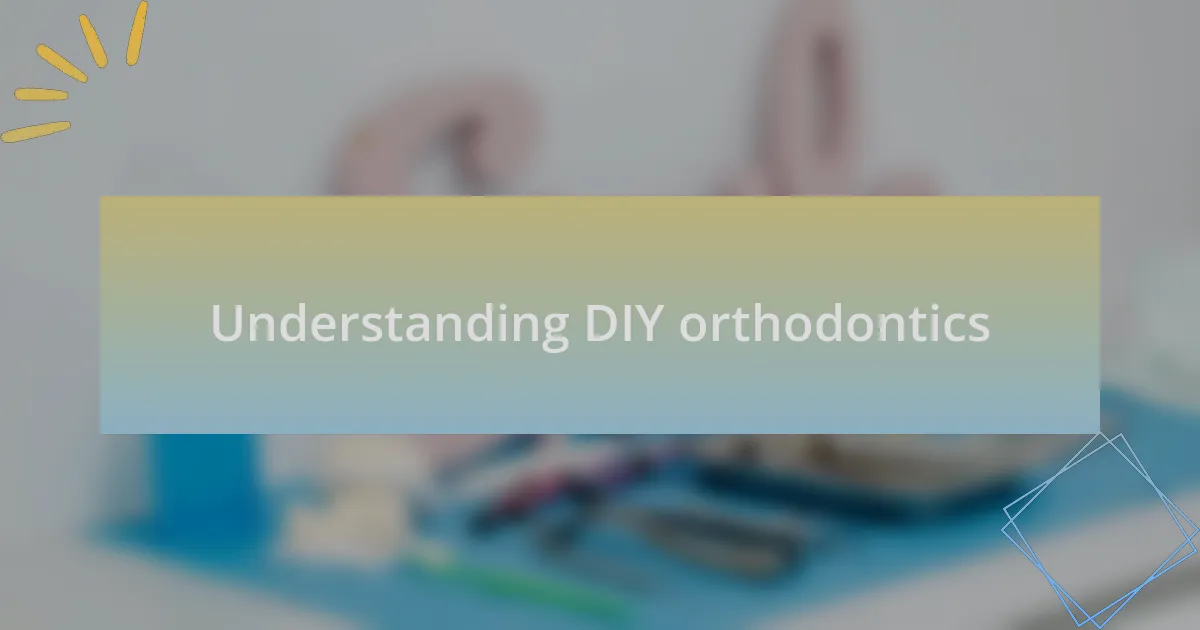
Understanding DIY orthodontics
DIY orthodontics refers to the practice of attempting to straighten teeth or correct bite issues without professional guidance. I recall a friend who was so determined to achieve a perfect smile that she purchased an online kit, convinced it would be a simple solution. However, she soon learned that adjusting teeth is far more complex than it seems; each alignment requires careful consideration of the jaw’s structure and the specific movement needed for each tooth.
The surge in interest for DIY orthodontics often stems from a desire for affordability and convenience. But I can’t help but wonder—how many people really understand the potential risks involved? One case that struck me was a colleague who tried a DIY kit and ended up with severe discomfort and a misaligned bite, leading to years of corrective treatment. That experience reinforced my belief that while the allure of a lower price point is tempting, the consequences can outweigh the savings.
It’s critical to remember that orthodontics isn’t just about aesthetics; it’s about ensuring long-term dental health. I often think back to my own orthodontic journey and the care I received from my orthodontist. The personalized treatment I got was invaluable, highlighting the nuanced approach professionals take compared to a one-size-fits-all kit. Isn’t it worth investing in your dental health when the stakes are so high?
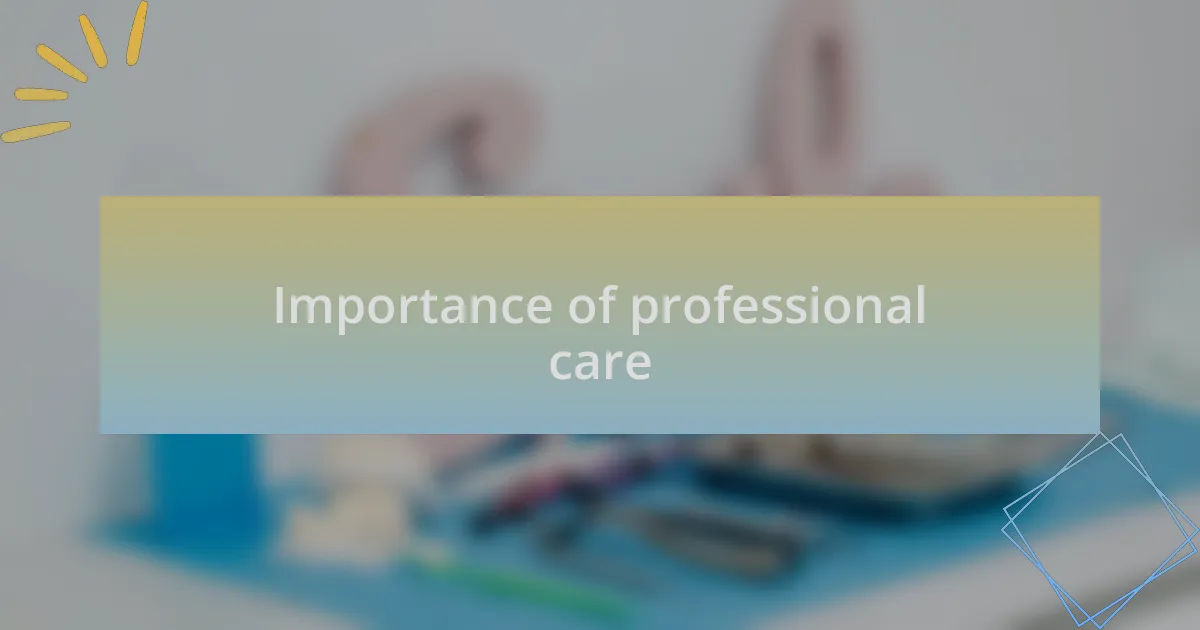
Importance of professional care
When it comes to orthodontics, seeking professional care is paramount. I remember my own orthodontist explaining how misalignment could lead to more than just a cosmetic issue; it can impact our bite and overall dental health. Can you imagine the long-term consequences of neglecting those details? I certainly wouldn’t want anyone to face years of discomfort simply for a quick fix.
Consider the precision that skilled professionals bring to the table. When I first met my orthodontist, he took the time to analyze my teeth’s individual needs. He didn’t apply a cookie-cutter approach; instead, he devised a detailed plan tailored just for me. This kind of thoughtful care is something a DIY kit simply can’t offer, don’t you agree?
Furthermore, professional orthodontic treatment involves continuous monitoring and adjustments. I once heard a patient recount her experience with DIY braces that ended disastrously. She faced not only physical pain but also a hefty financial burden when she had to correct the issues caused by her initial choice. It makes me wonder how many others might end up in a similar situation, realizing too late that professional guidance is invaluable.
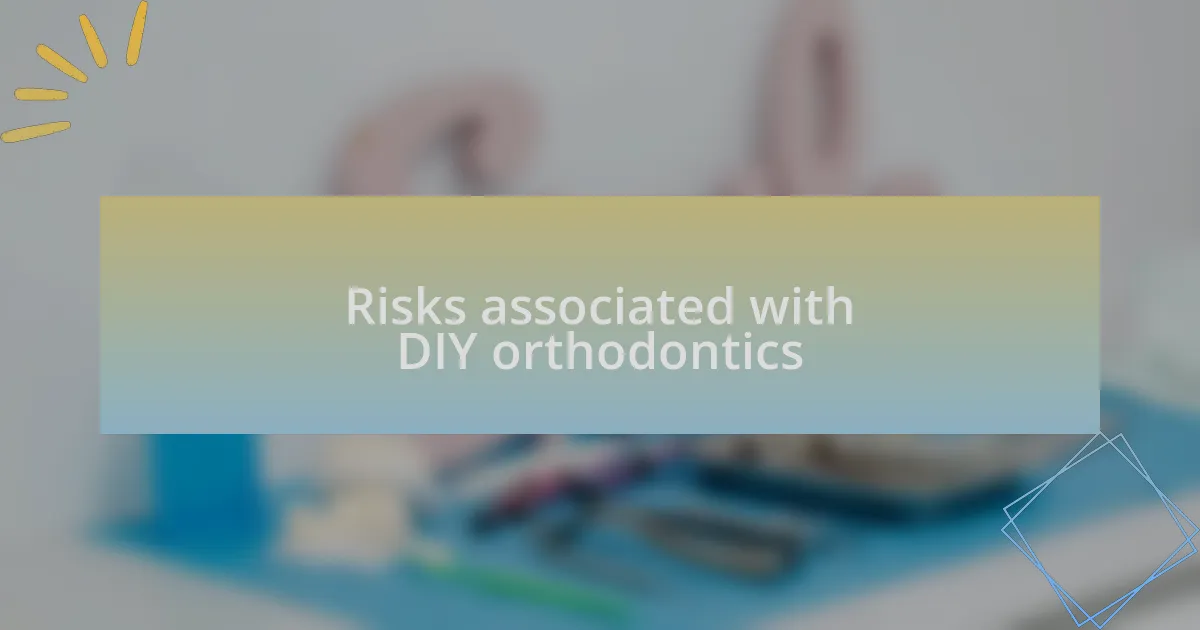
Risks associated with DIY orthodontics
Attempting DIY orthodontics can lead to serious complications. I once encountered a friend who tried to adjust her own aligners after watching a few online videos. What started as a minor adjustment quickly escalated into severe discomfort and even tooth loss. Has anyone ever paused to consider the potential damage that could occur from misguided attempts at self-treatment?
Improper fitting of DIY devices can cause teeth to shift in unexpected ways. I remember hearing from a colleague who used a DIY kit, and he regretted it deeply when his teeth moved in the wrong direction. That experience was eye-opening; it really made me think about how every tooth is interconnected, and messing with one can set off a chain reaction throughout the mouth.
Plus, infection is a genuine risk when using unsterilized DIY materials. I read about a person who ended up with an abscess because they didn’t understand the importance of hygiene. It’s moments like these that remind us: investing in professional care helps avoid dangerous outcomes that DIY attempts might bring. Do we really want to jeopardize our health for what seems like a cost-effective shortcut?
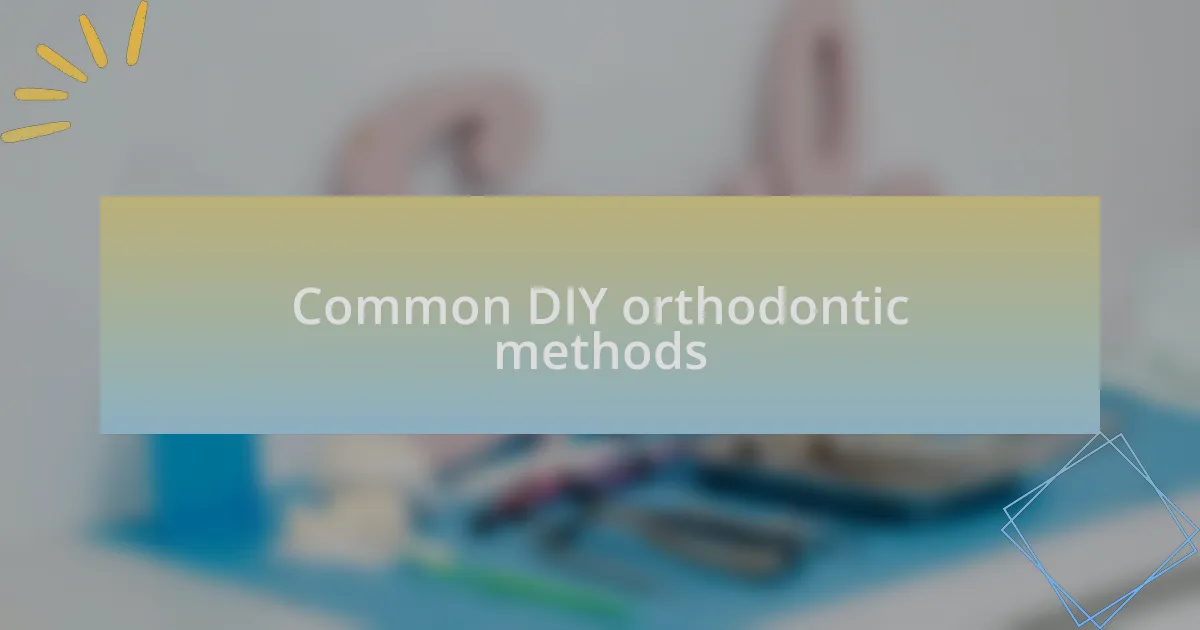
Common DIY orthodontic methods
Many people turn to rubber bands or household items like paper clips in their quest for straighter teeth. I remember a young patient who tried using rubber bands to close gaps between her teeth. Initially, it seemed harmless, but she soon found herself in a world of pain when the bands slipped off and caused her teeth to move unevenly. I often wonder, is a quick fix worth the long-term consequences?
Another common method involves using do-it-yourself aligner kits available online. A friend of mine decided to take this route after seeing ads that promised perfect teeth at home. Unfortunately, without professional guidance, he ended up exacerbating an underlying bite issue that severely impacted his jaw alignment. Don’t we owe it to ourselves to seek proper treatment rather than gamble with our smiles?
Some even resort to 3D printing their own aligners right at home. While this technology is fascinating, it’s crucial to have an understanding of dental anatomy and mechanics. I once watched a video tutorial showcasing this method, and I couldn’t help but think how tempting it might be for someone not aware of the intricate balance within the mouth. Are we truly qualified to create something so vital without supervision?
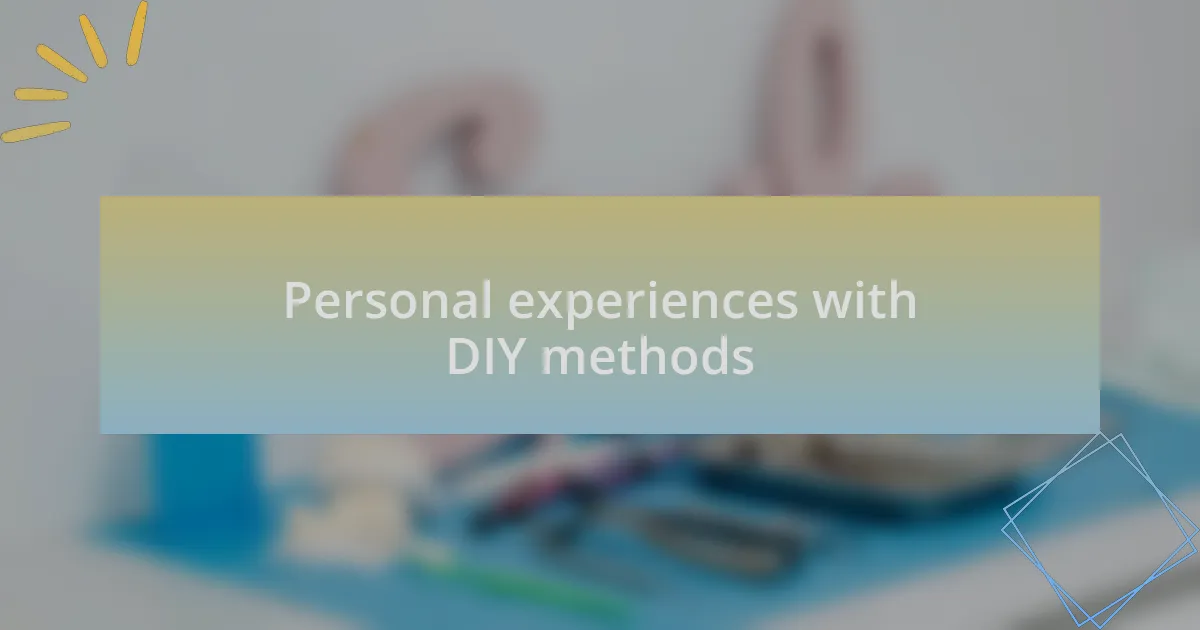
Personal experiences with DIY methods
I’ve had a chance to observe friends who dabbled in DIY orthodontics, and their experiences were quite eye-opening. One friend, excited by an Instagram post, tried to create his own retainers with materials he found online. At first, the notion of saving money thrilled him, but within weeks, he noticed his teeth shifting even more. This situation made me think: how often do we prioritize saving a few bucks over our long-term well-being?
Another time, I listened to a colleague who attempted to fix his crooked smile using a mixture of dental wax and fishing line. This unorthodox method led to discomfort, and he eventually had to spend double the amount to correct the mess he made. It left me questioning the validity of quick fixes: are we so desperate for immediate results that we overlook the risks involved?
In my own practice, I’ve seen a handful of adults who came in after trying to DIY their teeth with the help of online videos. Their stories often include discomfort and regrets. I can’t help but wonder, don’t we deserve to approach such an important aspect of our health through informed methods rather than the latest viral trend? The more I delve into their experiences, the more I feel we need to emphasize the value of professional guidance in orthodontics.
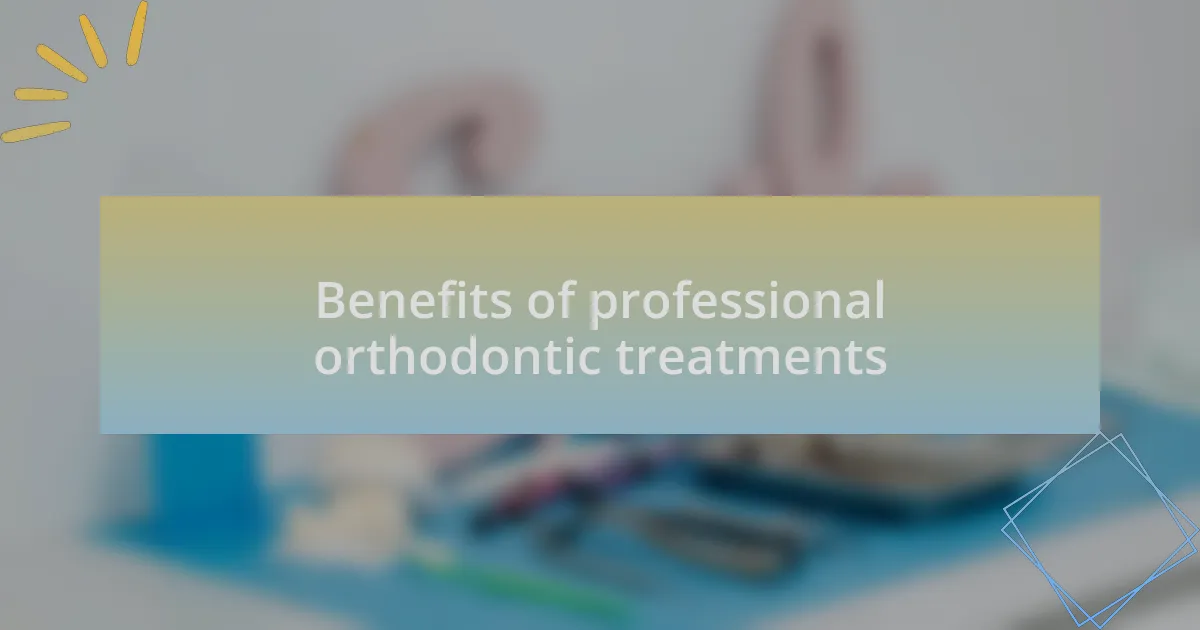
Benefits of professional orthodontic treatments
Professional orthodontic treatments offer a level of expertise that DIY methods simply cannot match. I remember when a patient came in after years of believing that over-the-counter aligners would suffice. She faced not just aesthetics issues but also serious bite problems that a professional would have addressed right from the start. Isn’t it fascinating how a trained eye can anticipate potential complications before they become a significant concern?
Additionally, receiving ongoing support from an orthodontist means you have someone who monitors your progress closely. I once had a young teenager who was nervous about the entire braces experience. With tailored strategies and constant check-ins, her confidence grew, and she embraced her treatment journey. Isn’t it reassuring to know that professional care includes emotional support throughout?
Lastly, the benefits of professional treatments extend to the overall health of your teeth and gums. I’ve seen cases where untreated misalignments led to gum disease or TMJ issues later in life. Isn’t that a higher cost to pay than investing in quality orthodontic care upfront? The peace of mind that comes from knowing you’re making the best choices for your oral health is priceless.
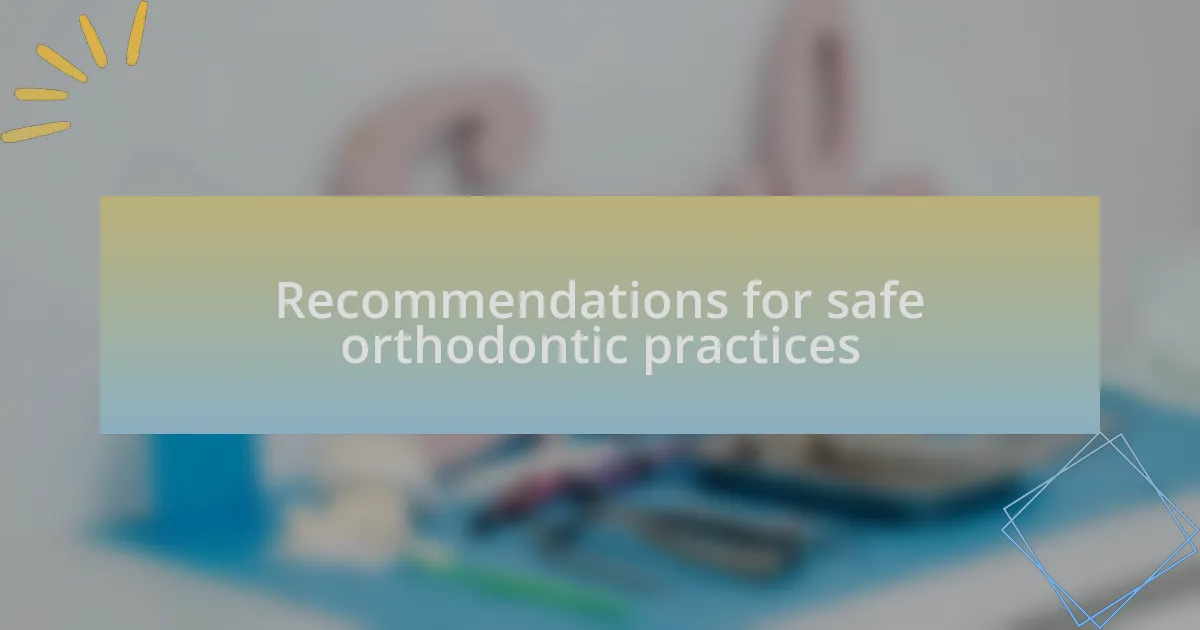
Recommendations for safe orthodontic practices
When considering safe orthodontic practices, it’s crucial to prioritize professional guidance over DIY approaches. I once consulted with someone who tried to realign their teeth using household items like rubber bands. Unfortunately, this led to increased pain and potential damage to their gums. Isn’t it a sobering thought that a simple decision could result in long-term harm?
Regular check-ups with an orthodontist are essential, as they can provide tailored advice based on individual needs. I remember a patient who initially hesitated to seek help, thinking DIY methods were sufficient. Once they realized the importance of professional oversight, they were amazed by the difference in both their comfort level and treatment efficiency. Don’t you think having a knowledgeable partner during the process can make all the difference?
Moreover, maintaining good oral hygiene is non-negotiable during any orthodontic treatment. I once had a patient who neglected their cleaning routine and faced setbacks because of new cavities developing under their braces. It was a tough lesson, but it underscored how interconnected oral care and orthodontics truly are. Wouldn’t you agree that prioritizing both is essential for the best outcomes?